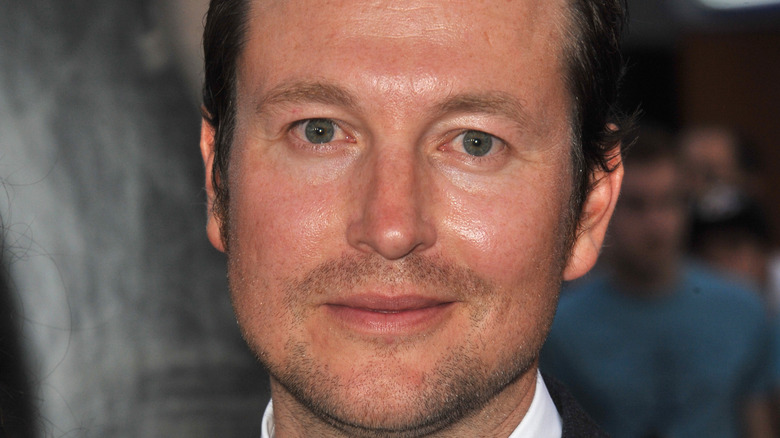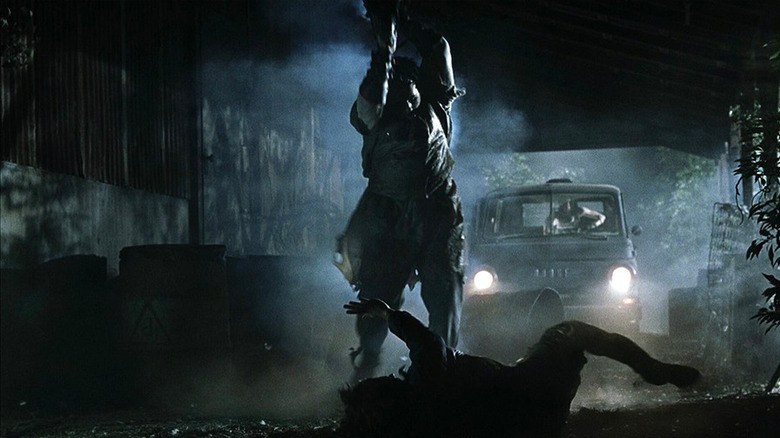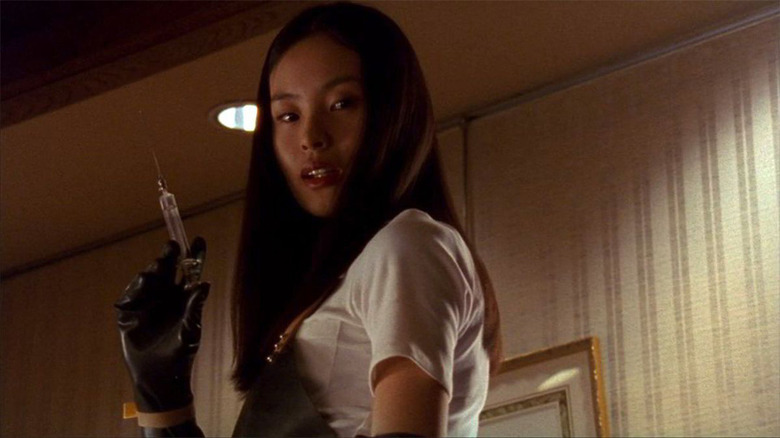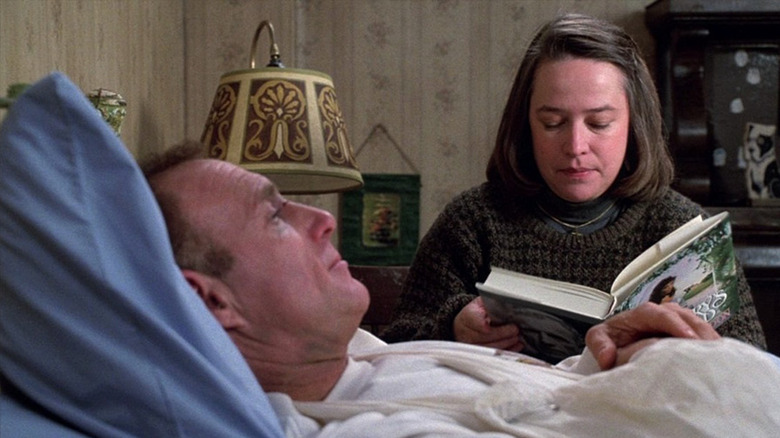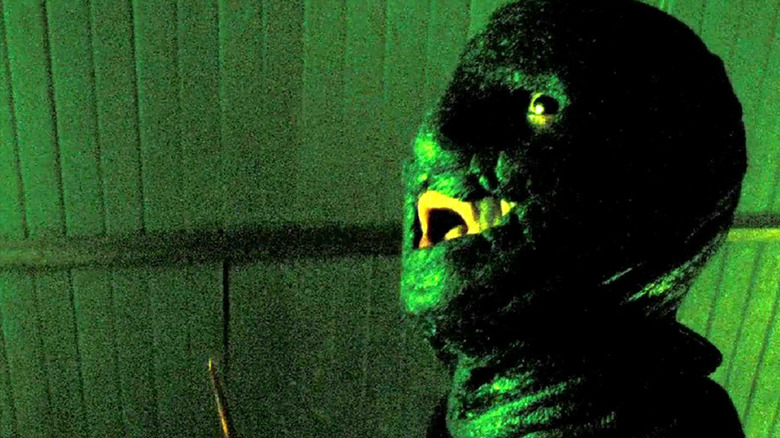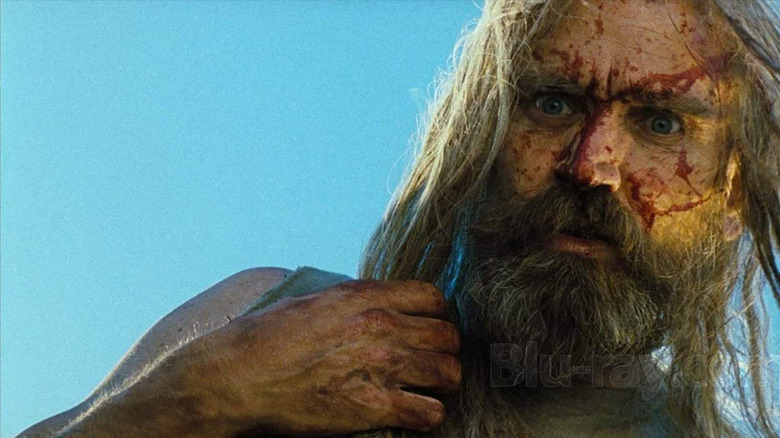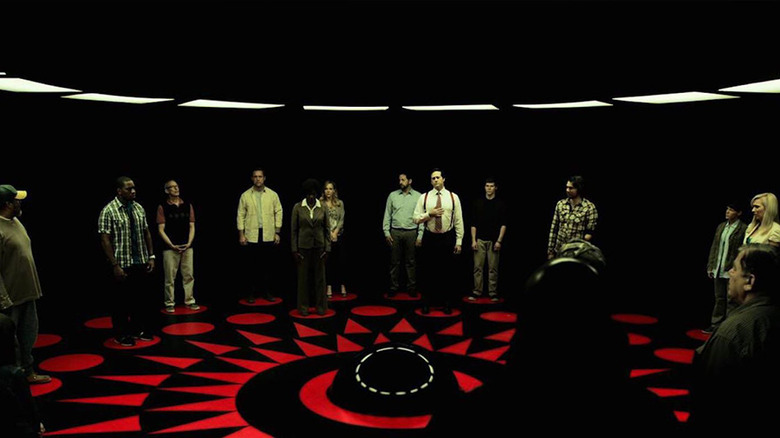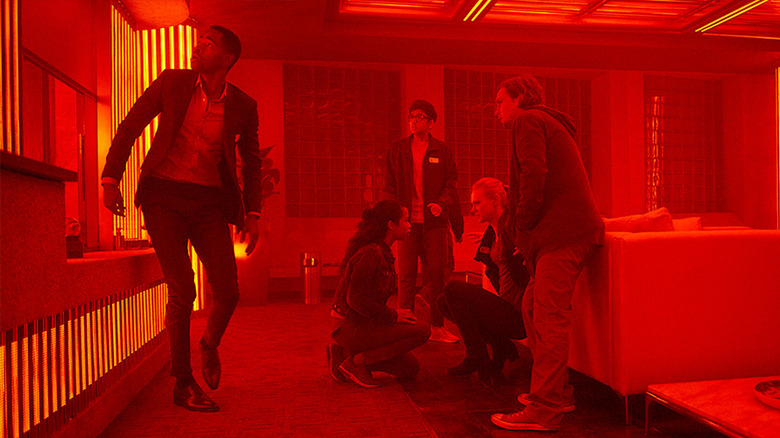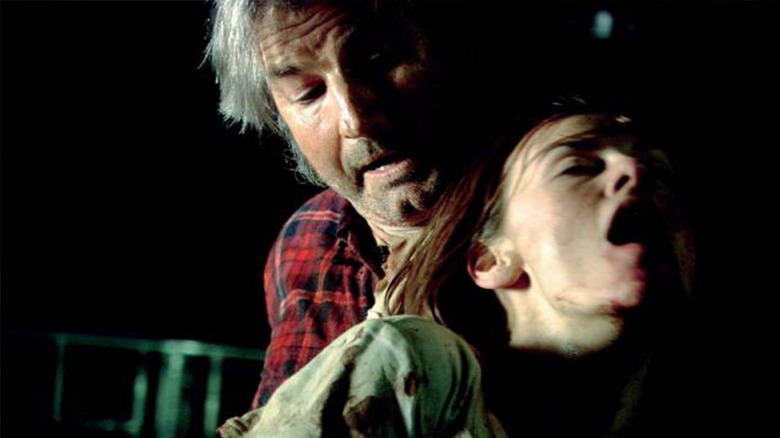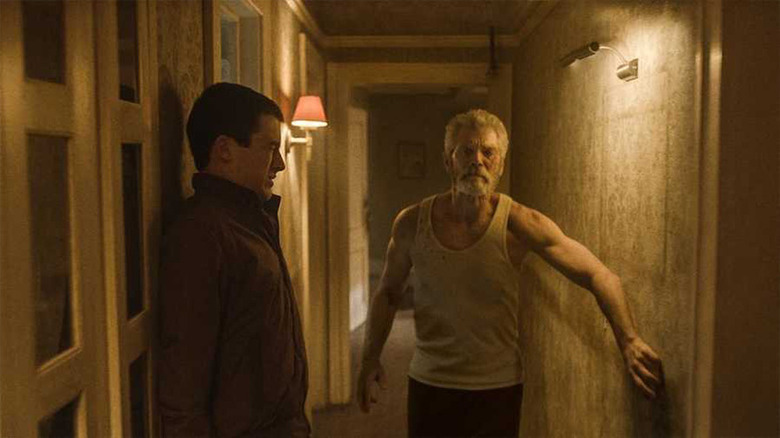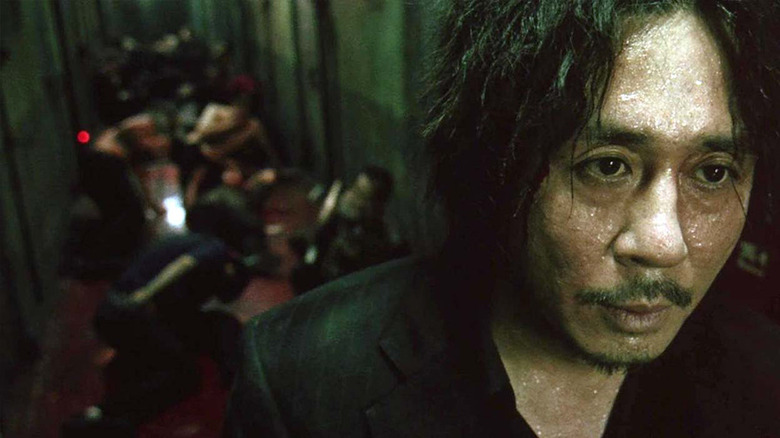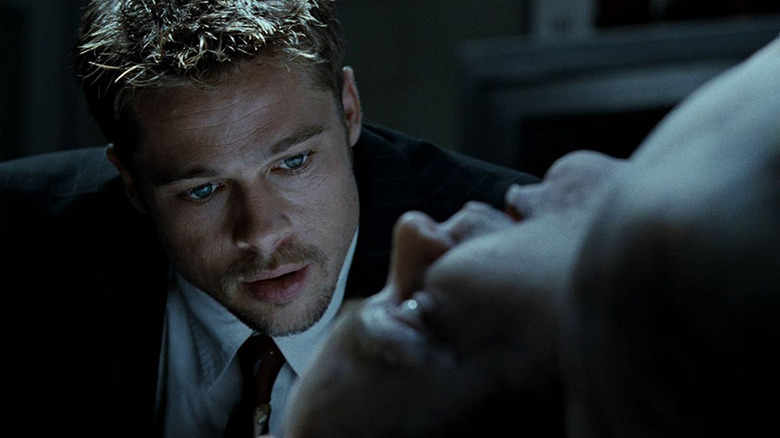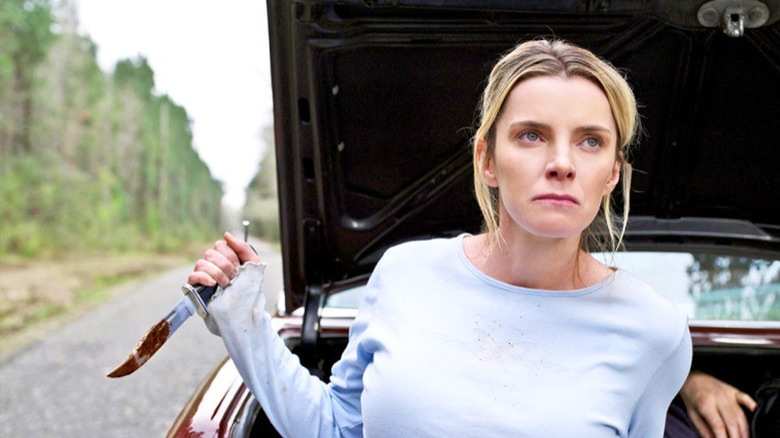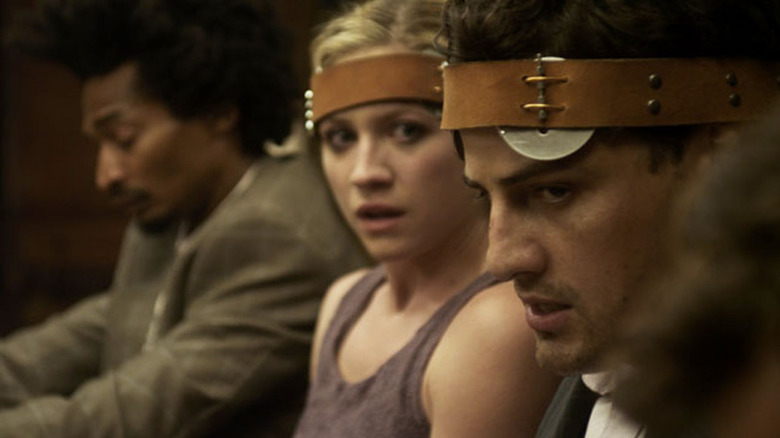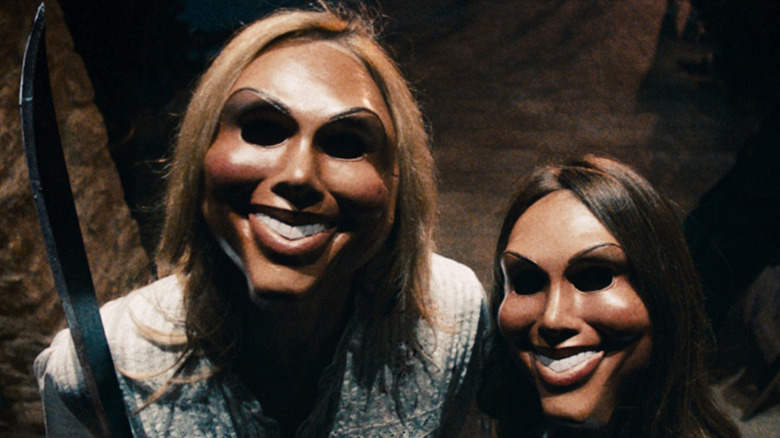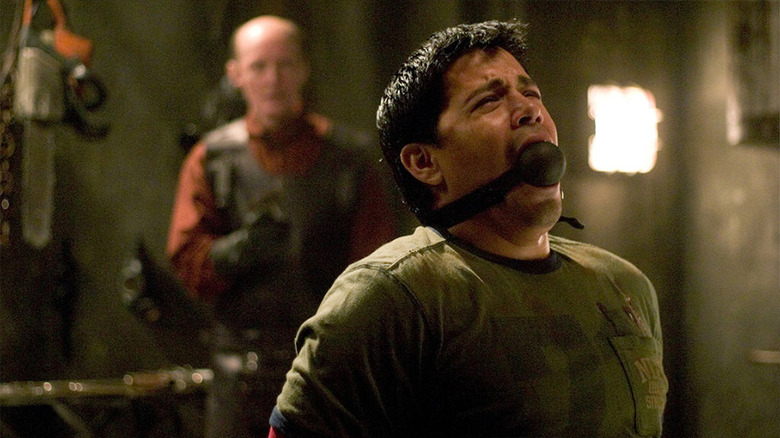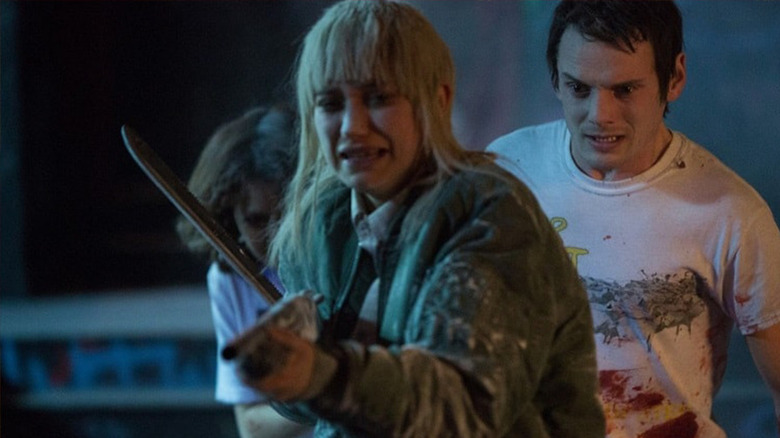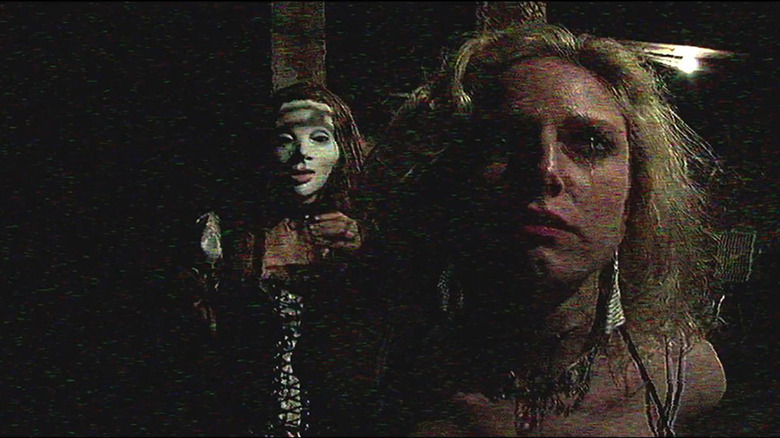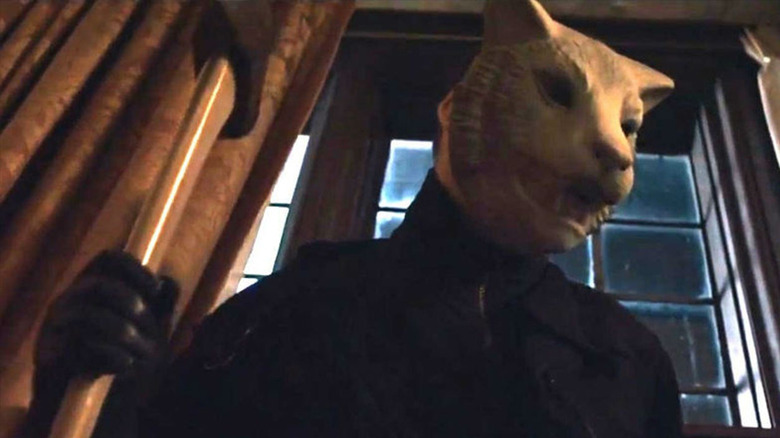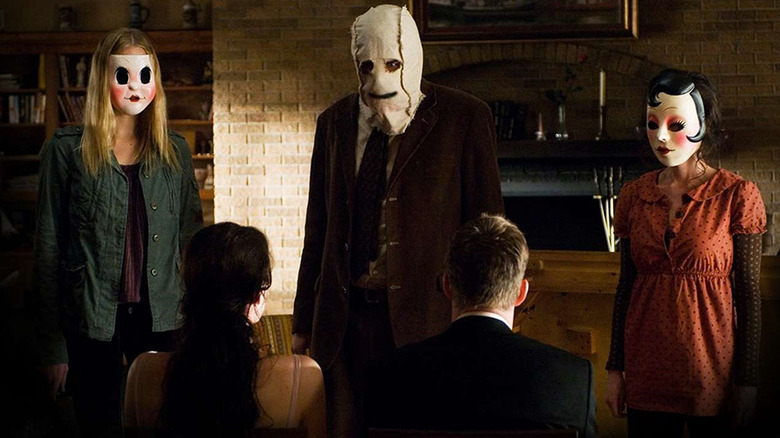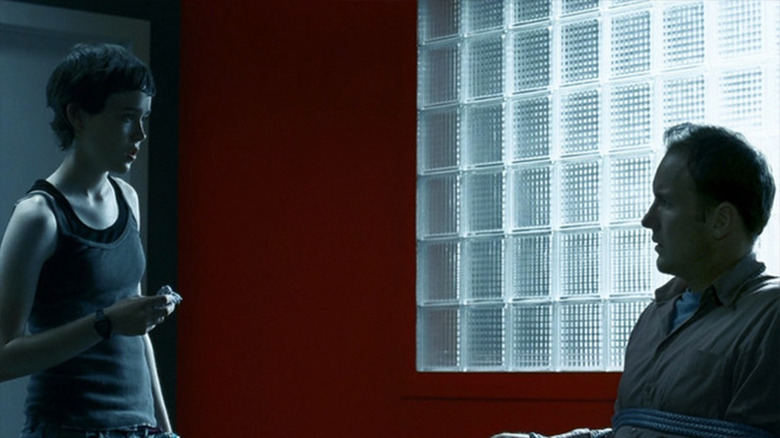20 Movies Like Saw You Need To See Next
If you're just starting to explore the horror genre, you should know that it's an extremely vast category with numerous weird sub-niches (splatterpunk, we're looking at you) and a long roster of directors. Whether you're looking for something thought-provoking or just mindlessly entertaining, horror has something for you. It also helps that the genre has a presence in countries other than the United States, making it very accessible.
"Saw" is a classic in this category. With its mix of mystery and disturbing visuals, the movie has a little bit of everything, making it a perfect watch for horror heads and newbies alike. If you just watched it and are craving more, these are 20 films from various decades and creators are worth checking out.
Fair warning: Many of these films are notorious for their levels of violence, disturbing subject matter, or even for just one key moment. If that's outside your comfort zone, by all means, leave now. If you're up for something messed up, proceed.
The Texas Chainsaw Massacre (2003)
There is no denying that the original "Texas Chainsaw Massacre" was pure lightning in a bottle, oft-imitated but never truly duplicated. From its grisly, almost documentary-style visuals to its horrific sound design, the film still terrifies almost 50 years later. While no subsequent film in the franchise has ever truly matched the original's quality, it is worth shining a light on the 2003 remake. Directed by Marcus Nispel and written by Scott Kosar, the remake wisely chooses not to replicate the original's style. Instead, the entire film oozes dread and disgust throughout every frame of its runtime, despite its flashier cinematography and undeniably trashy nature. Additionally, the film amps up the gore, especially when compared to the rather subdued original.
Much like "Saw," this film is quite effective at creating a grotesque environment. The cast is rounded out by some legitimate talent as well, including Jessica Biel in her first notable mainstream role. Not to be forgotten is the incomparable R. Lee Ermey, who brings equal parts humor and sadistic malice to his part. While the original film is by far superior, there are still many quality elements in this remake that deserve praise and attention.
Audition (1999)
When it comes to Japanese cinema, there are few directors as notorious and revered as Takashi Miike. His films are noteworthy for their unrelenting depictions of violence and gleeful levels of sadism. Nowhere are these recurring motifs more present than in Miike's film "Audition," often regarded as one of the gnarliest horror films of all time.
Shigeharu Aoyama, a recent widower, is convinced by his producer friend to use a faux audition to find the perfect woman. After much trial and error, Shigeharu is eventually smitten with the soulful Asami Yamazaki. Unfortunately, Asami is harboring some dark and disturbing secrets that Shigeharu begins to uncover. As Asami's dark past starts to affect the present, Shigeharu realizes his life might be in danger. This results in one of the most brutal and stomach-churning torture sequences in cinematic history. Trust us, no details are spared. It's the perfect cherry on top of a film that keeps you in a state of constant unease and tension. If "Saw" gave you a craving for more stylized human misery, then look no further than "Audition"—a true gem if there ever was one.
Misery (1990)
One of the many strengths of "Saw" is how simple its premise is: two guys chained up in a grimy bathroom by an evil puppet master. Another film that benefits from its bare-bones nature is "Misery," the Rob Reiner-helmed adaptation of the Stephen King novel. The story concerns novelist Paul Sheldon (James Caan), who has just finished the soon-to-be final entry in his "Misery" book series. His journey home from the mountains results in a car accident that leaves Paul unconscious in the snow. He ends up in the care of former nurse Annie Wilkes (Kathy Bates), who just so happens to be Paul's No. 1 fan. Things take a turn for the creepy when Annie—enraged by Paul killing off her favorite character from "Misery"—holds him hostage to write a new version.
To say this film is both disturbing and suspenseful would be a gross understatement, as "Misery" is a nearly perfect psychological thriller (especially if you like your thrills with a dash of camp). James Caan plays Paul Sheldon with a mix of convincing fear and even humor, especially when showing his growing hostility towards Annie. Of course, the most memorable aspect of the entire film is Kathy Bates as Annie Wilkes. Bates played the role with such a convincing level of cheeriness and disturbing rage that it secured her an Academy Award in 1991.
The Collector (2009)
If you are looking for a film to watch after the "Saw" movies, look no further than a film that was originally meant to be one. "The Collector" focuses on Arkin, a cat burglar trying to steal a sizable ruby from a house he's cased via his job as a handyman. What should be a simple in-and-out job quickly turns into a nightmare. Arkin has unwittingly broken into a horror film already in progress, as the titular Collector has turned the house into a sadistic maze of traps. This begins an expertly paced game of cat and mouse as Arkin tries to escape with his loot without becoming the Collector's next victim.
The film's biggest asset is Josh Stewart as Arkin. The actor brings a welcome level of savvy and intelligence to the lead role. The Collector himself is also thoroughly intimidating; he doesn't utter a single word and wears a very disturbing mask. Complete with solid direction, cinematography, and a heart-pounding score, the film makes for a nail-biting experience.
The Devil's Rejects (2005)
Rob Zombie is perhaps one of horror's most divisive directors, with his signature style being the subject of much praise and criticism. Opinions may differ, there's no denying that "The Devil's Rejects" is one of the most brutal horror films of the last three decades. Serving as a sequel to his 2003 release "House of 1000 Corpses," the film might as well exist on another planet. Gone is the "Hellbilly Deluxe"-inspired Rockabilly visuals. In its place is a more grounded, but equally repugnant film. The story focuses on the Firefly trio (Otis, Baby, and Captain Spaulding), who attempt to evade the law after a raid on their family home. Much like "Saw," this film excels in two main areas: gore and unrelenting human misery.
The insanely endearing characters make the film such an entertaining watch. Bill Moseley, Sheri Moon Zombie, and the late Sid Haig all have incredible chemistry with one another, which results in endlessly quotable dialogue. The three effortlessly go from sadistically torturing an entire family to childishly bickering about roadside ice cream. It's Rob Zombie's finest work and a reminder of just how relentless Western horror can be under the right direction.
Circle (2015)
How do you make a movie about people standing in a circle for 90 minutes suspenseful? "Circle," like "Saw," is a prime example of the "less is more" approach to filmmaking. It has a sinisterly simple concept. Fifty people get stuck in a circular room and eventually discover that unless they all vote to eliminate someone, one of them will be killed every two minutes regardless. The situation leads to a barrage of petty squabbles, lies, deception, and personal agendas—all while they're trying to figure out how and why they're even there. Along the way, alliances are formed, and everything from age to illness and even race is used to justify certain eliminations.
What makes the film work so well is its reliance on mostly unknown actors (aside from Julie Benz and Carter Jenkins). This gives the film a sense of legitimacy, as you truly feel as though you've been thrust into an intense conflict with complete strangers. The creators of the film, Aaron Hann and Mario Miscione, have noted in past interviews that the film's screenplay was largely inspired by "12 Angry Men." If you've wondered what Reginald Rose's writing would be like with science fiction elements and 38 more angry people, check out "Circle."
Escape Room (2019)
"Escape Room" takes a few pages out of the "Saw" franchise's playbook, but definitely goes in its own direction. Unlike the "Saw" movies, which focus more on the gory traps as they go on, this movie emphasizes ingenuity and puzzle-solving (fittingly enough, the main antagonist of this film and its sequel is named the Puzzle Maker). The first film follows a group of six players—Zoey, Ben, Amanda, Mike, Danny, and Jason—who are invited to play an escape room for a big cash prize. With the money being too good to pass up, they all accept, but things quickly turn sinister and the puzzles presented rapidly become deadlier.
Where "Escape Room" shines most is in its cast, who deliver convincing performances. The creative nature of the puzzles presented throughout is also appealing. Far from the most original movie, "Escape Room" still provides enough suspense and atmosphere to satisfy any "Saw" fan's appetite.
Wolf Creek (2005)
If ever there was a horror film that kept you guessing up until its final moments, it'd definitely be "Wolf Creek." Released in 2005, the film—helmed by Australian director Greg McLean—is an intense dramatization of real-life murders. Between 1989 and 1993, during the height of the Australian hitchhiking trend, the bodies of several young backpackers were discovered in the Belanglo State Forest. As noted in the book "Australian Horror Films" by Peter Shelley, these events inspired McLean to retool a previously written screenplay he was unsatisfied with titled "Wolf Creek." The film itself focuses on a trio of backpackers who end up in the crosshairs of the murderous Mick Taylor.
After running into Mick, who lures them in under the guise of fixing their car, their nightmare begins. What ensues is a brutal fight for survival where every conventional horror rule or trope is thrown out the window. Characters built to be the standard horror movie survivor are killed off in grisly fashion, creating an unpredictable experience. The highlight of the film is undoubtedly John Jarratt, who brings equal parts menace and dark humor to the role of Mick. It's no wonder that he and the film developed an immense cult following, resulting in sequels (one set for this year) and a television series.
Don't Breathe (2016)
"Don't Breathe" is a perfect example of a movie that will have you desperately craving a shower after viewing it. The film is directed by Fede Álvarez, the same creative force behind the "Evil Dead" reimagining and upcoming "Texas Chainsaw Massacre" sequel. Much like in the "Evil Dead," Álvarez utilizes his keen eye for dilapidated locations to masterful effect. Three Detroit youths have a pretty solid side hustle breaking into homes and making off with various goodies. They find what appears to be the score of a lifetime: $300,000 held in the home of Norman Nordstrom (Stephen Lang).
This looks to be their easiest job to date, with the only real risk appearing to be Norman's sizable dog. However, shortly after breaking in, the trio quickly learns that Norman isn't what he appears to be. The film shines for its unrelenting suspense, stomach-churning twists, anxiety-inducing third act, and believable performances. Jane Levy is particularly impressive as Rocky, a character who's equal parts relatable and resourceful. Not to be overshadowed is Stephen Lang, who, with his gruff voice and daunting physique, plays a thoroughly convincing psychopath. From its opening sequence to its final moments, "Don't Breathe" will have your heart ready to jump into your throat.
Oldboy (2003)
When you sit down for a Park Chan-wook film, you are guaranteed a gorgeous experience rife with dark humor and unrelenting brutality. These are qualities that his 2003 release, "Oldboy," has in spades, as it deals not only with psychological torture but also vengeance. We are introduced to Oh Dae-su, an ordinary businessman who is kidnapped after being arrested ahead of his daughter's fourth birthday. He is thrown into a hotel room sealed off from the world. What's worse, he sees on the news that his wife has been murdered. Dae-su spends the next 15 years with only the television and his own decaying mind for company. Upon his release, Dae-su has only one goal on his mind: vengeance. He immediately begins his hunt for his captors.
Choi Min-sik brings so much to the character of Oh Dae-su, from physical prowess to a unique blend of sympathy and psychosis. Chan-wook's direction is also stellar. The hallway fight scene partway through the film is still regarded as an amazing sequence nearly 20 years later. Like "Saw," it's a film that rewards the viewer's endurance and appreciation for dark subject matter.
Se7en (1995)
When you sit down to watch a David Fincher movie, you can never be quite sure what you're going to get. Sometimes it can be a grounded drama like "The Social Network." Other times, it's a soulful fantasy, like "The Curious Case of Benjamin Button." Fincher has fingerprints on just about every genre and cinematic style known to man, including psychological crime thrillers. When it comes to fictional movies about serial killers, there is something undeniably unique about "Se7en," due in no small part to Fincher's direction. The film centers on fresh-faced detective David Mills (Brad Pitt), who is partnered with the grizzled William Somerset (Morgan Freeman) on a case involving a slew of killings based on the seven deadly sins.
One of this film's most notable qualities is its ability to make the viewer feel unclean. Fincher achieves this not only through the grimy, rusted aesthetic but also through the shocking directions of the killer, especially when we're shown his handiwork. Pitt and Freeman are both in top form and share genuine chemistry, which only heightens the now-legendary climax. If you're a fan of true crime and would love to see a fictional narrative in that same vein, definitely check out "Seven."
The Hunt (2020)
"The Hunt" is a film that was hit with rather debilitating circumstances far ahead of its intended release. The film was originally set for a release on September 27, 2019, but was changed after the mass shootings in Dayton and El Paso. After being pulled from Universal's release schedule, the film finally reached silver screens in March of 2020—just in time for the COVID-19 pandemic. Much like "The Invisible Man" and "Trolls: World Tour," the film's theatrical run was cut short and it was sent straight to on-demand. On top of that, the film was criticized by the right for its premise (liberals hunting conservatives). "The Hunt" was a truly snakebitten film.
It's important to note all of that because it all seemed to overshadow the film itself, which, despite some minor issues, is an entertaining watch. The film focuses on a group of people who are hunted by what is revealed to be a shadowy group of manor-dwelling elites. At the center of these psychotic events is Crystal May Creasey (played by Betty Gilpin, who many might recognize as Liberty Belle from "GLOW"). Gilpin is definitely the standout of the film, delivering a performance that is equal parts intense and hilarious. Despite all the needless controversy, "The Hunt" is a solid political satire with mild narrative problems held aloft by the strength of its main lead.
Would You Rather (2012)
"Saw" brought prolonged human suffering back into modern cinema in a big way, as evidenced by the wave of imitators released in its wake. Countless films have seen one or more individuals placed into a deadly game for survival. Despite the oversaturation (especially in the 2000s), some films rise above the sub-genre's cliches. "Would You Rather" is a great example of taking the torture genre to its most extreme and logical conclusion. The film, directed by David Guy Levy, concerns Iris, a young woman who wants nothing more to help her brother Raleigh. Unable to afford the treatment for Raleigh's leukemia, Iris accepts an offer to participate in a parlor game at a wealthy philanthropist's dinner party. The game seems simple enough, but as the night continues, Iris and the other players realize their lives are at stake.
The film doesn't relent when it comes to its level of darkness or gruesome violence. "Would You Rather" is undoubtedly an endurance test of a film, but one that will impress you with its sheer dedication to its themes and ideas.
The Purge (2013)
"The Purge" series is a great example of a fairly simple concept evolving beyond its original self-contained presentation (very much like the "Saw" franchise). The inaugural film tells the story of Purge Night, a yearly tradition when all crime is legal for 12 hours. We see these events from the perspective of the Sandin family, helmed by James (Ethan Hawke) and Mary (Lena Headey). Equipped with the finest in security technology, the family is prepared to ride out the night in peace and safety. This quickly goes up in smoke when their son allows an injured homeless man to seek refuge in their home. This leads to the arrival of a group of disturbed youths led by the cruel Henry, who offers the Sandins a haunting ultimatum: hand over the homeless man—their intended victim—or the entire family will die.
The film is, at its core, a home invasion film against a backdrop of a very disturbing look at America's future. This is a concept that has been taken even further in sequels, prequels, and a television series.
Hostel (2005)
In the early 2000s, Eli Roth was a rising star in the horror world. Still fresh off his first hit film, "Cabin Fever," Roth was being offered many different mainstream projects. It wasn't until a dip in the pool with legendary director Quentin Tarantino that Roth was encouraged to pursue his original idea of a Euro-centered horror movie based around legitimately disturbing websites he'd seen on the dark web. Inspired by this poolside powwow, Roth—with support from Tarantino—began crafting the script for "Hostel."
The film focuses on American college students Paxton and John, who are on a European tour with their friend Oli. This trip eventually lands them in the crosshairs of a secret organization that specializes in procuring victims to be mutilated by their wealthy clientele. The film is tasteless, but there's undeniable passion behind its visceral, highly graphic sequences. Despite receiving a mixed reaction from critics at the time, "Hostel" grossed $82 million against its $4.8 million budget and earned itself two sequels ("Hostel: Part 2," directed by Roth again, and "Hostel: Part III," which went straight to home media).
Green Room (2015)
If you were to bottle pure, concentrated dread and anxiety into a single film, it would most definitely be "Green Room." Following up on his previous films, "Murder Party" and "Blue Ruin," director Jeremy Saulnier capitalized on an idea he'd been tinkering with for a while: a thriller where the majority of the events occur in a green room. The appeal of "Green Room" comes from the "Saw"-like simplicity of its plot and its stylized violence.
The story concerns the Ain't Rights, a D.C. punk band touring the Pacific Northwest in search of gigs and hopefully their big break. Unfortunately, one such gig takes them to a bar outside Portland frequented by Neo-Nazis. After Pat (Anton Yelchin) witnesses a murder following the band's set, he and his bandmates barricade themselves in the green room as the Nazi leader, Darcy (Patrick Stewart), looks to eliminate any witnesses. What ensues is a brutal fight for survival that results in mutilations and a growing number of casualties. The film's violence is brutal, yet reserved, not lingering on anything very long, which adds to the film's emotionally detached mood.
The Poughkeepsie Tapes (2007)
The next piece in our gallery of cinematic pain is a top-shelf example of it, this time from the found-footage sub-genre. "The Poughkeepsie Tapes" is a faux-documentary about the heinous actions of an unnamed serial killer. In the film, a police raid in Poughkeepsie, New York, results in over 800 videotapes documenting the actions of the killer. What ensues is a slew of shocking kidnappings, killings, and disturbingly prolonged torture sessions. The found-footage element underscores the film's horrific realism and depravity.
If you thought "Saw" turned the dial up to 11, "The Poughkeepsie Tapes" goes even higher, pushing the genre past any previously established threshold. The bulk of the film consists of the killer psychologically and physically torturing a young Cheryl Dempsey (Stacy Chbosky). These sequences are unrelentingly brutal and make the film a true endurance test to watch. By the time the credits roll, your nerves are guaranteed to be stretched razor-thin.
You're Next (2011)
Everyone has been to an awkward family gathering at one time or another, but it's unlikely that any have gone as poorly as the one shown in "You're Next." This home invasion horror film comes courtesy of Adam Wingard, the director behind "The Guest" and "Godzilla vs. Kong." Rin (Sharni Vinson) is thrust into a fight for her life when her husband's family reunion goes from uncomfortable to deadly in an instant. During a heated family dinner, three attackers in animal masks begin menacing the family with crossbows and machetes. The body count quickly rises, and it's up to Rin to fight off the attackers before the entire family is slaughtered.
The film's biggest strength is its direction. Wingard has an impeccable sense for gratuitous gore layered with dark humor. Much like "Saw," the film was rewarded for its ingenuity with an impressive $26.9 million gross against its estimated $1 million budget. If you are looking for a fresh take on the home invasion sub-genre, definitely check out "You're Next"
The Strangers (2008)
The real-life plausibility of the home invasion genre makes it especially disturbing and anxiety-inducing. "The Strangers" takes the category back to basics: no high-concept purge night, no comedic angle, just three truly depraved attackers. A couple, James (Scott Speedman) and Kristen (Liv Tyler), head to James' childhood summer home after a friend's wedding. Their quiet night is interrupted by a stranger at the door: an odd young woman who asks them if someone named Tamara is home. From there, everything begins to go off the rails as the girl and two more masked assailants begin to menace the couple.
"The Strangers" doesn't do anything revolutionary with its concept, but it succeeds in its execution. The film's director/writer, Bryan Bertino, explained that he was inspired by classic horror of the 1970s and various real home invasions. This is clear through the film's brisk pacing and its effective use of suspense, especially in the first half. One of the titular Strangers often looms in the background with no musical accompaniment, going totally unseen by the main characters. Much like the first "Saw" film, "The Strangers" does a lot with very little, crafting an engaging and extremely disturbing scenario.
Hard Candy (2005)
"Hard Candy" is a provocative film, but that's part of its strength. Per the DVD commentary, the plot was inspired by Japanese news stories of young girls tricking older businessmen into meeting up, only to assault and rob them. In "Hard Candy," we are introduced to 14-year-old Hayley Stark (Elliot Page) and 32-year-old Jeff Kohlver (Patrick Wilson), who, after some online flirting, meet in real life. The situation is undeniably predatory; anyone can deduce that Jeff has less-than-wholesome intentions for Hayley. The film promptly pulls the rug from underneath the viewer with its twist: Hayley, who knows of Jeff's past predation, is on a mission to get revenge on him.
The film and its uncomfortable subject matter make for an extremely nauseating, yet enthralling experience. Both Page and Wilson are in top form here, turning the standard horror movie power dynamic on its head. If "Saw" gave you a taste of how dark horror movies can be, definitely test your resolve with "Hard Candy." Don't say we didn't warn you, though.
